University Name: MGMT1101 - Air Canada Business Analysis Project
VerifiedAdded on 2022/09/07
|12
|2268
|21
Project
AI Summary
This project provides a comprehensive business analysis of Air Canada, examining its market position through SWOT and PESTEL analyses. The project identifies Air Canada's strengths, such as its strong financial position and extensive network, and weaknesses, including technological issues and decreasing market share. Opportunities for growth include route expansion and low-cost flights, while threats include competition from low-cost airlines and external factors. The analysis incorporates PESTEL factors, considering political, economic, social, technological, environmental, and legal influences on Air Canada's operations. The project also identifies key stakeholders, organizational structure (hierarchical), and recommends the application of Maslow's hierarchy of needs to motivate employees and concurrent control to manage market risks. The conclusion emphasizes the importance of strategic adaptation and effective control mechanisms for Air Canada's continued success in the aviation industry.
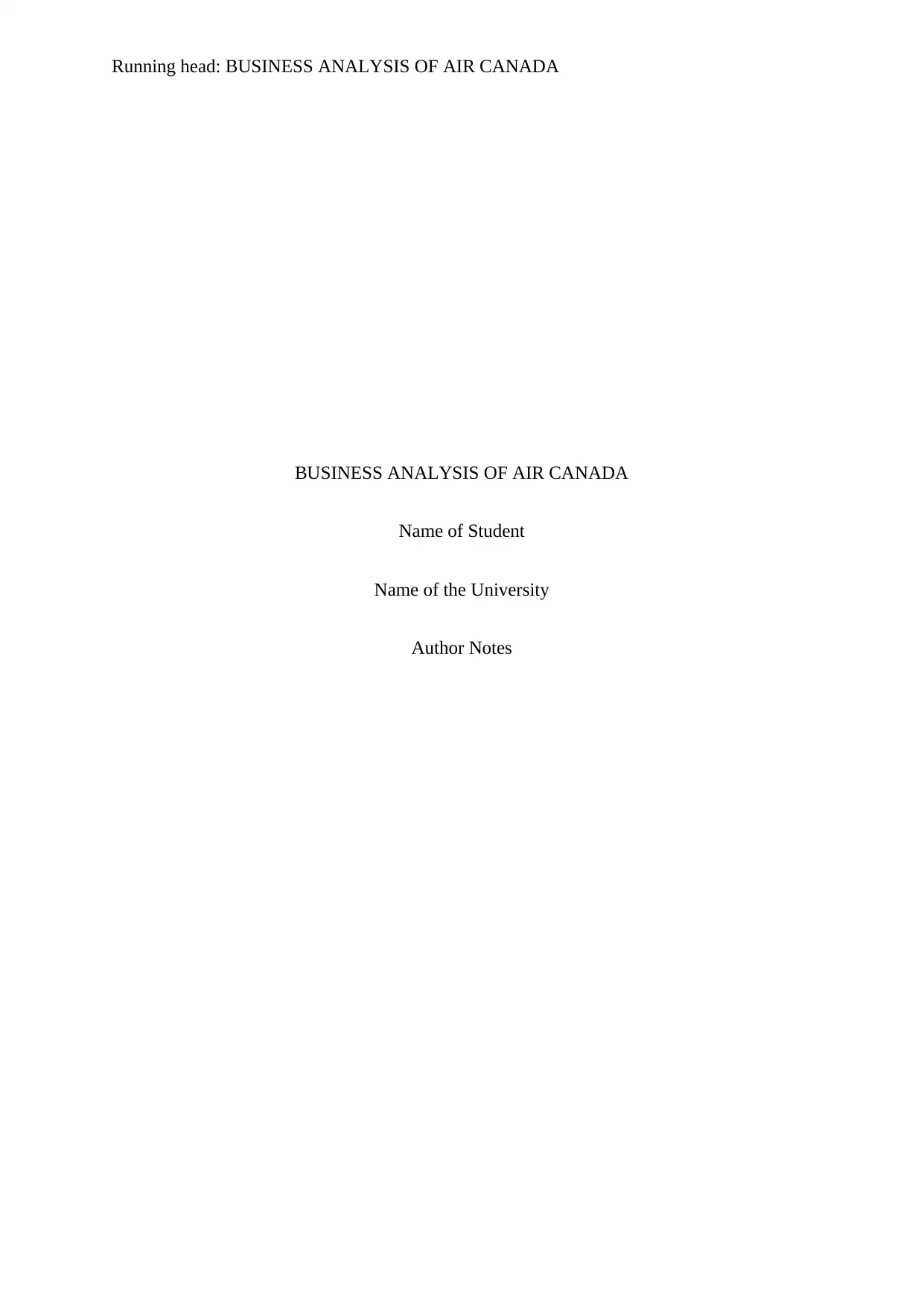
Running head: BUSINESS ANALYSIS OF AIR CANADA
BUSINESS ANALYSIS OF AIR CANADA
Name of Student
Name of the University
Author Notes
BUSINESS ANALYSIS OF AIR CANADA
Name of Student
Name of the University
Author Notes
Paraphrase This Document
Need a fresh take? Get an instant paraphrase of this document with our AI Paraphraser
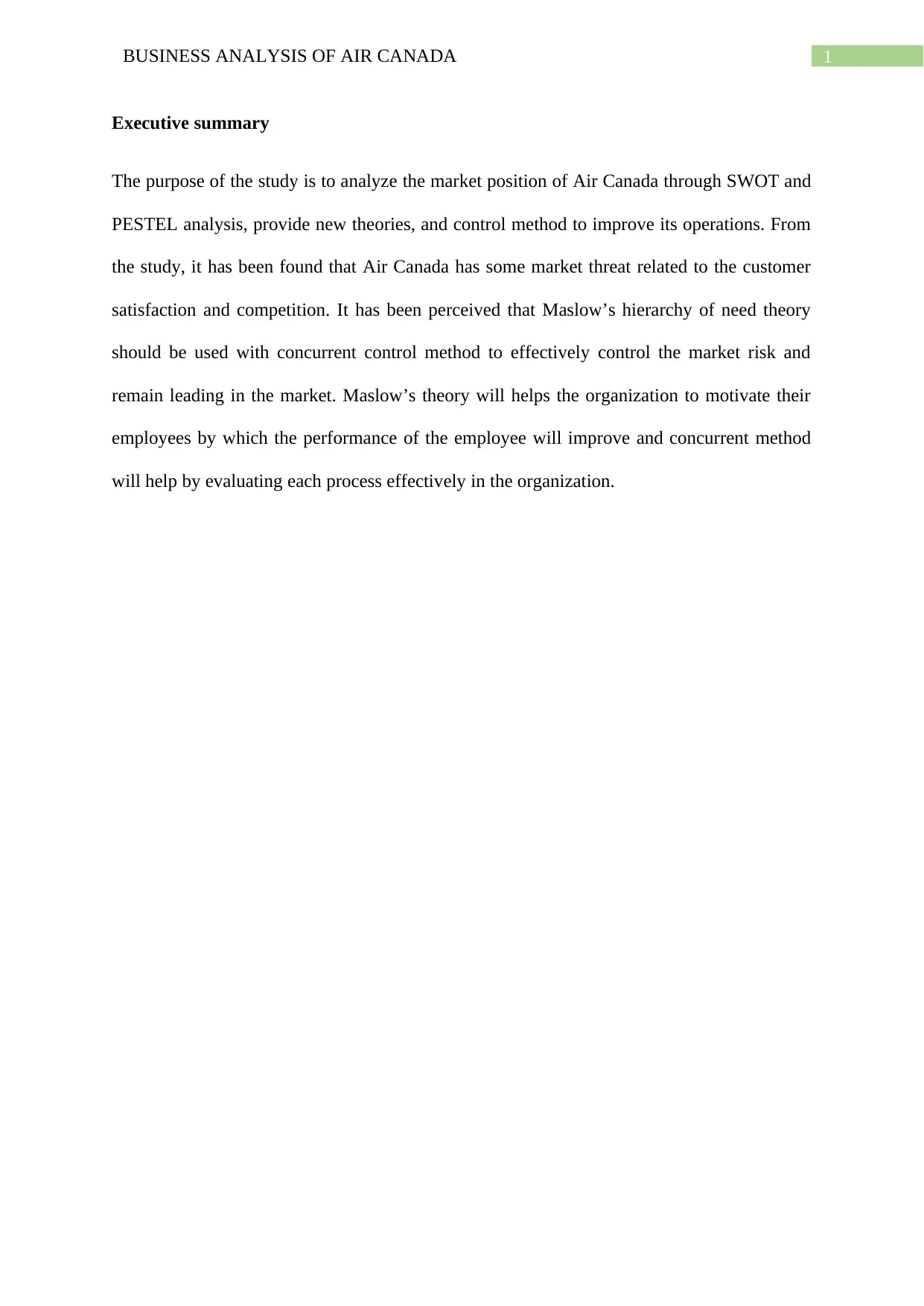
1BUSINESS ANALYSIS OF AIR CANADA
Executive summary
The purpose of the study is to analyze the market position of Air Canada through SWOT and
PESTEL analysis, provide new theories, and control method to improve its operations. From
the study, it has been found that Air Canada has some market threat related to the customer
satisfaction and competition. It has been perceived that Maslow’s hierarchy of need theory
should be used with concurrent control method to effectively control the market risk and
remain leading in the market. Maslow’s theory will helps the organization to motivate their
employees by which the performance of the employee will improve and concurrent method
will help by evaluating each process effectively in the organization.
Executive summary
The purpose of the study is to analyze the market position of Air Canada through SWOT and
PESTEL analysis, provide new theories, and control method to improve its operations. From
the study, it has been found that Air Canada has some market threat related to the customer
satisfaction and competition. It has been perceived that Maslow’s hierarchy of need theory
should be used with concurrent control method to effectively control the market risk and
remain leading in the market. Maslow’s theory will helps the organization to motivate their
employees by which the performance of the employee will improve and concurrent method
will help by evaluating each process effectively in the organization.
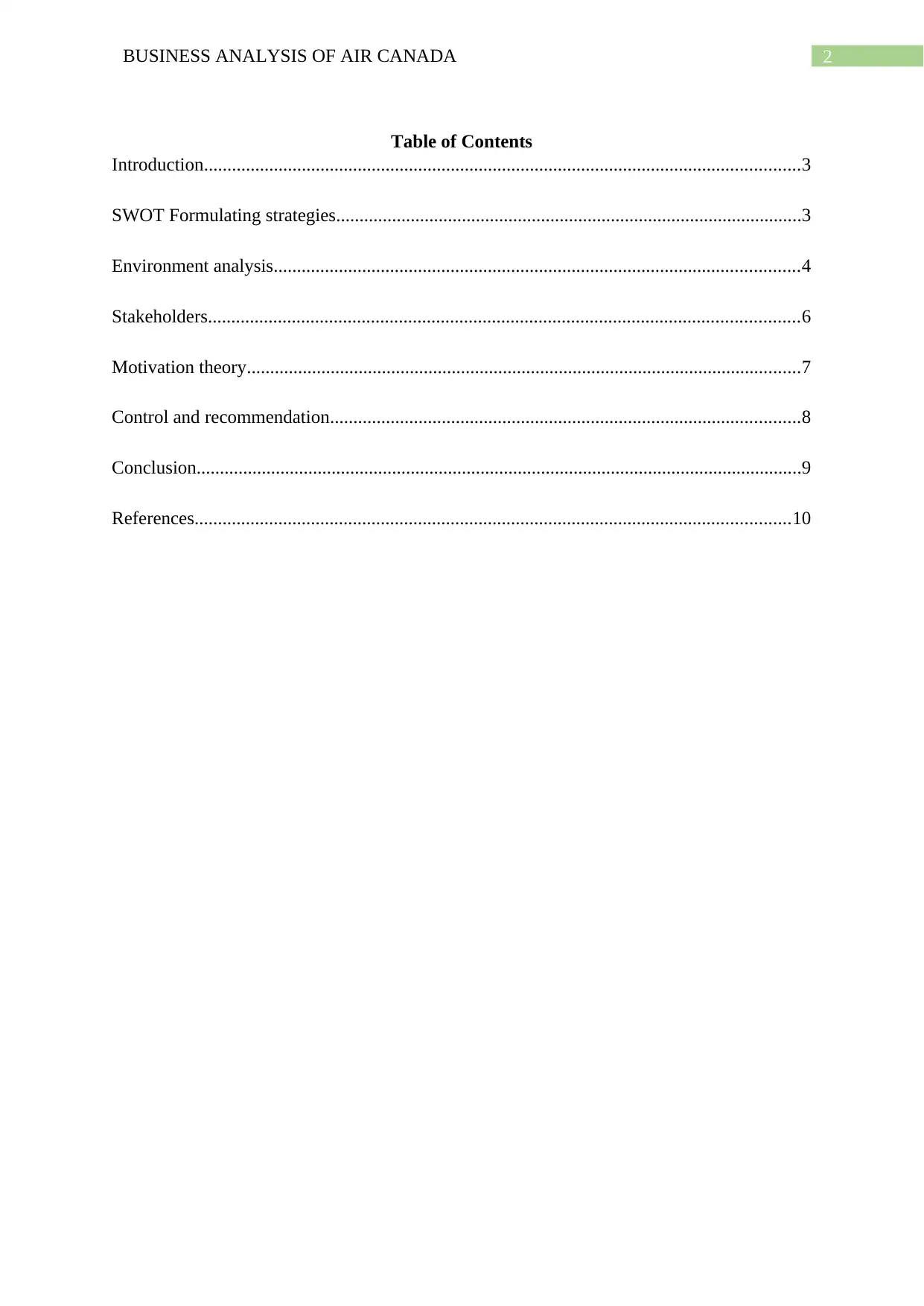
2BUSINESS ANALYSIS OF AIR CANADA
Table of Contents
Introduction................................................................................................................................3
SWOT Formulating strategies....................................................................................................3
Environment analysis.................................................................................................................4
Stakeholders...............................................................................................................................6
Motivation theory.......................................................................................................................7
Control and recommendation.....................................................................................................8
Conclusion..................................................................................................................................9
References................................................................................................................................10
Table of Contents
Introduction................................................................................................................................3
SWOT Formulating strategies....................................................................................................3
Environment analysis.................................................................................................................4
Stakeholders...............................................................................................................................6
Motivation theory.......................................................................................................................7
Control and recommendation.....................................................................................................8
Conclusion..................................................................................................................................9
References................................................................................................................................10
⊘ This is a preview!⊘
Do you want full access?
Subscribe today to unlock all pages.

Trusted by 1+ million students worldwide
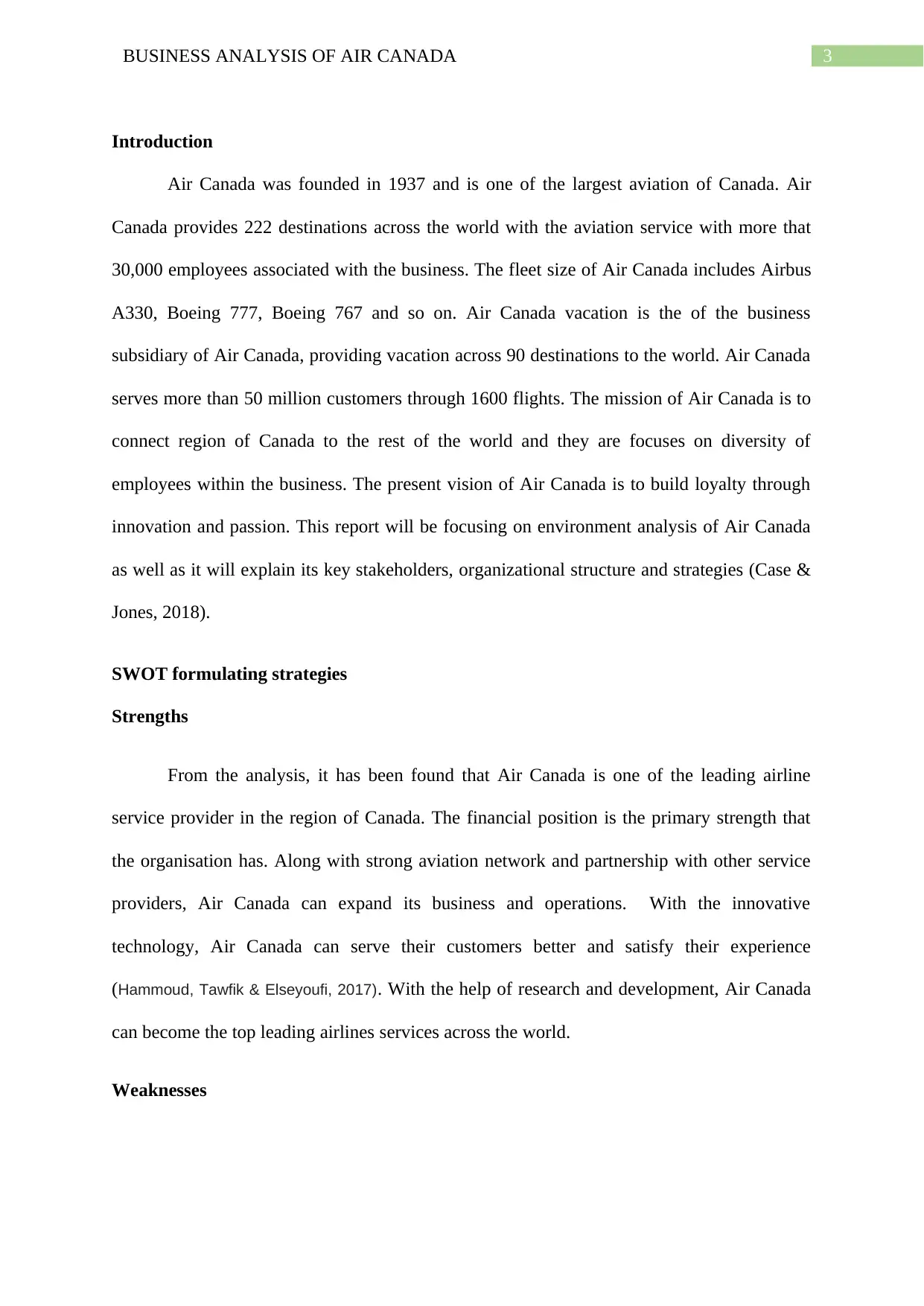
3BUSINESS ANALYSIS OF AIR CANADA
Introduction
Air Canada was founded in 1937 and is one of the largest aviation of Canada. Air
Canada provides 222 destinations across the world with the aviation service with more that
30,000 employees associated with the business. The fleet size of Air Canada includes Airbus
A330, Boeing 777, Boeing 767 and so on. Air Canada vacation is the of the business
subsidiary of Air Canada, providing vacation across 90 destinations to the world. Air Canada
serves more than 50 million customers through 1600 flights. The mission of Air Canada is to
connect region of Canada to the rest of the world and they are focuses on diversity of
employees within the business. The present vision of Air Canada is to build loyalty through
innovation and passion. This report will be focusing on environment analysis of Air Canada
as well as it will explain its key stakeholders, organizational structure and strategies (Case &
Jones, 2018).
SWOT formulating strategies
Strengths
From the analysis, it has been found that Air Canada is one of the leading airline
service provider in the region of Canada. The financial position is the primary strength that
the organisation has. Along with strong aviation network and partnership with other service
providers, Air Canada can expand its business and operations. With the innovative
technology, Air Canada can serve their customers better and satisfy their experience
(Hammoud, Tawfik & Elseyoufi, 2017). With the help of research and development, Air Canada
can become the top leading airlines services across the world.
Weaknesses
Introduction
Air Canada was founded in 1937 and is one of the largest aviation of Canada. Air
Canada provides 222 destinations across the world with the aviation service with more that
30,000 employees associated with the business. The fleet size of Air Canada includes Airbus
A330, Boeing 777, Boeing 767 and so on. Air Canada vacation is the of the business
subsidiary of Air Canada, providing vacation across 90 destinations to the world. Air Canada
serves more than 50 million customers through 1600 flights. The mission of Air Canada is to
connect region of Canada to the rest of the world and they are focuses on diversity of
employees within the business. The present vision of Air Canada is to build loyalty through
innovation and passion. This report will be focusing on environment analysis of Air Canada
as well as it will explain its key stakeholders, organizational structure and strategies (Case &
Jones, 2018).
SWOT formulating strategies
Strengths
From the analysis, it has been found that Air Canada is one of the leading airline
service provider in the region of Canada. The financial position is the primary strength that
the organisation has. Along with strong aviation network and partnership with other service
providers, Air Canada can expand its business and operations. With the innovative
technology, Air Canada can serve their customers better and satisfy their experience
(Hammoud, Tawfik & Elseyoufi, 2017). With the help of research and development, Air Canada
can become the top leading airlines services across the world.
Weaknesses
Paraphrase This Document
Need a fresh take? Get an instant paraphrase of this document with our AI Paraphraser
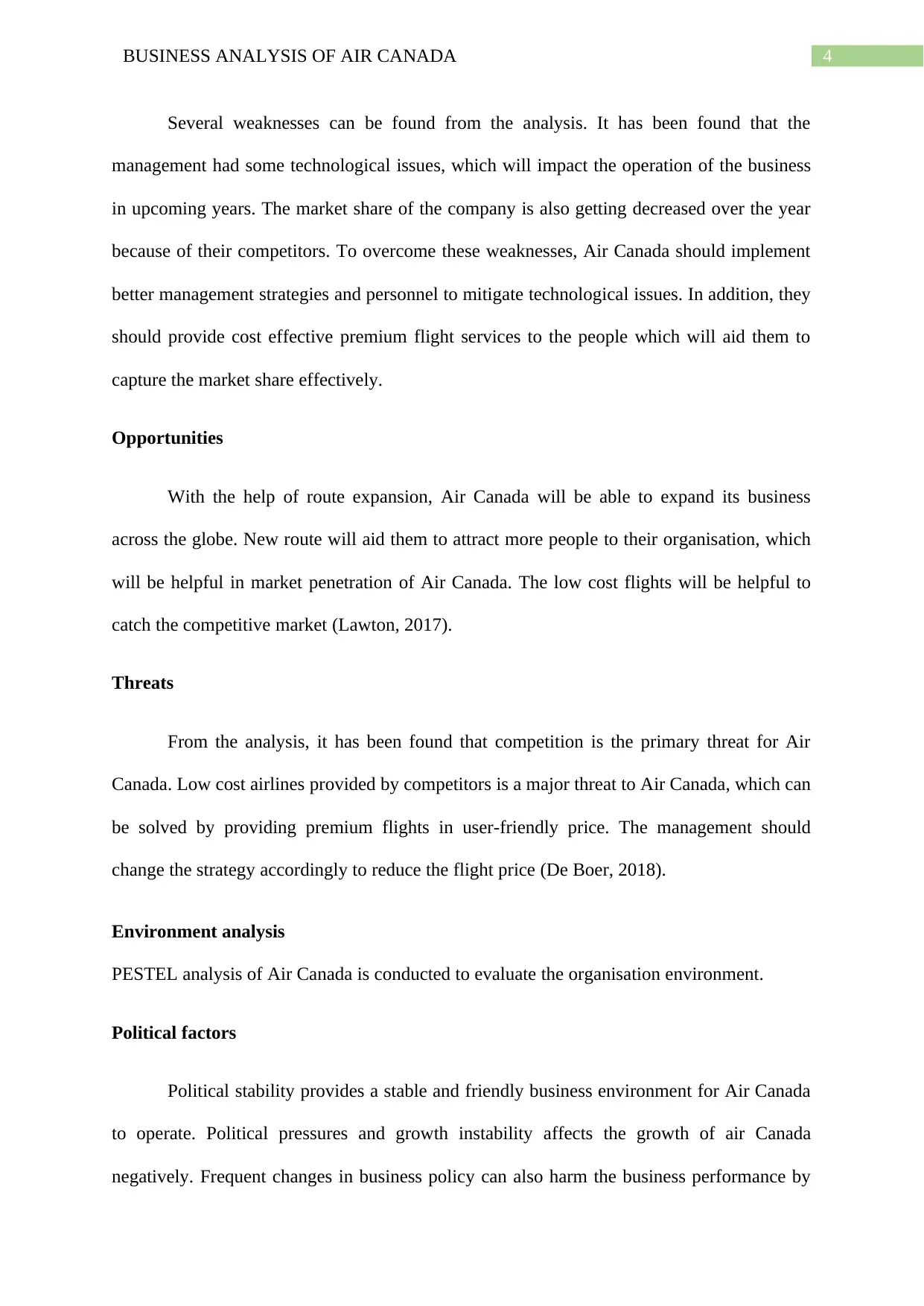
4BUSINESS ANALYSIS OF AIR CANADA
Several weaknesses can be found from the analysis. It has been found that the
management had some technological issues, which will impact the operation of the business
in upcoming years. The market share of the company is also getting decreased over the year
because of their competitors. To overcome these weaknesses, Air Canada should implement
better management strategies and personnel to mitigate technological issues. In addition, they
should provide cost effective premium flight services to the people which will aid them to
capture the market share effectively.
Opportunities
With the help of route expansion, Air Canada will be able to expand its business
across the globe. New route will aid them to attract more people to their organisation, which
will be helpful in market penetration of Air Canada. The low cost flights will be helpful to
catch the competitive market (Lawton, 2017).
Threats
From the analysis, it has been found that competition is the primary threat for Air
Canada. Low cost airlines provided by competitors is a major threat to Air Canada, which can
be solved by providing premium flights in user-friendly price. The management should
change the strategy accordingly to reduce the flight price (De Boer, 2018).
Environment analysis
PESTEL analysis of Air Canada is conducted to evaluate the organisation environment.
Political factors
Political stability provides a stable and friendly business environment for Air Canada
to operate. Political pressures and growth instability affects the growth of air Canada
negatively. Frequent changes in business policy can also harm the business performance by
Several weaknesses can be found from the analysis. It has been found that the
management had some technological issues, which will impact the operation of the business
in upcoming years. The market share of the company is also getting decreased over the year
because of their competitors. To overcome these weaknesses, Air Canada should implement
better management strategies and personnel to mitigate technological issues. In addition, they
should provide cost effective premium flight services to the people which will aid them to
capture the market share effectively.
Opportunities
With the help of route expansion, Air Canada will be able to expand its business
across the globe. New route will aid them to attract more people to their organisation, which
will be helpful in market penetration of Air Canada. The low cost flights will be helpful to
catch the competitive market (Lawton, 2017).
Threats
From the analysis, it has been found that competition is the primary threat for Air
Canada. Low cost airlines provided by competitors is a major threat to Air Canada, which can
be solved by providing premium flights in user-friendly price. The management should
change the strategy accordingly to reduce the flight price (De Boer, 2018).
Environment analysis
PESTEL analysis of Air Canada is conducted to evaluate the organisation environment.
Political factors
Political stability provides a stable and friendly business environment for Air Canada
to operate. Political pressures and growth instability affects the growth of air Canada
negatively. Frequent changes in business policy can also harm the business performance by
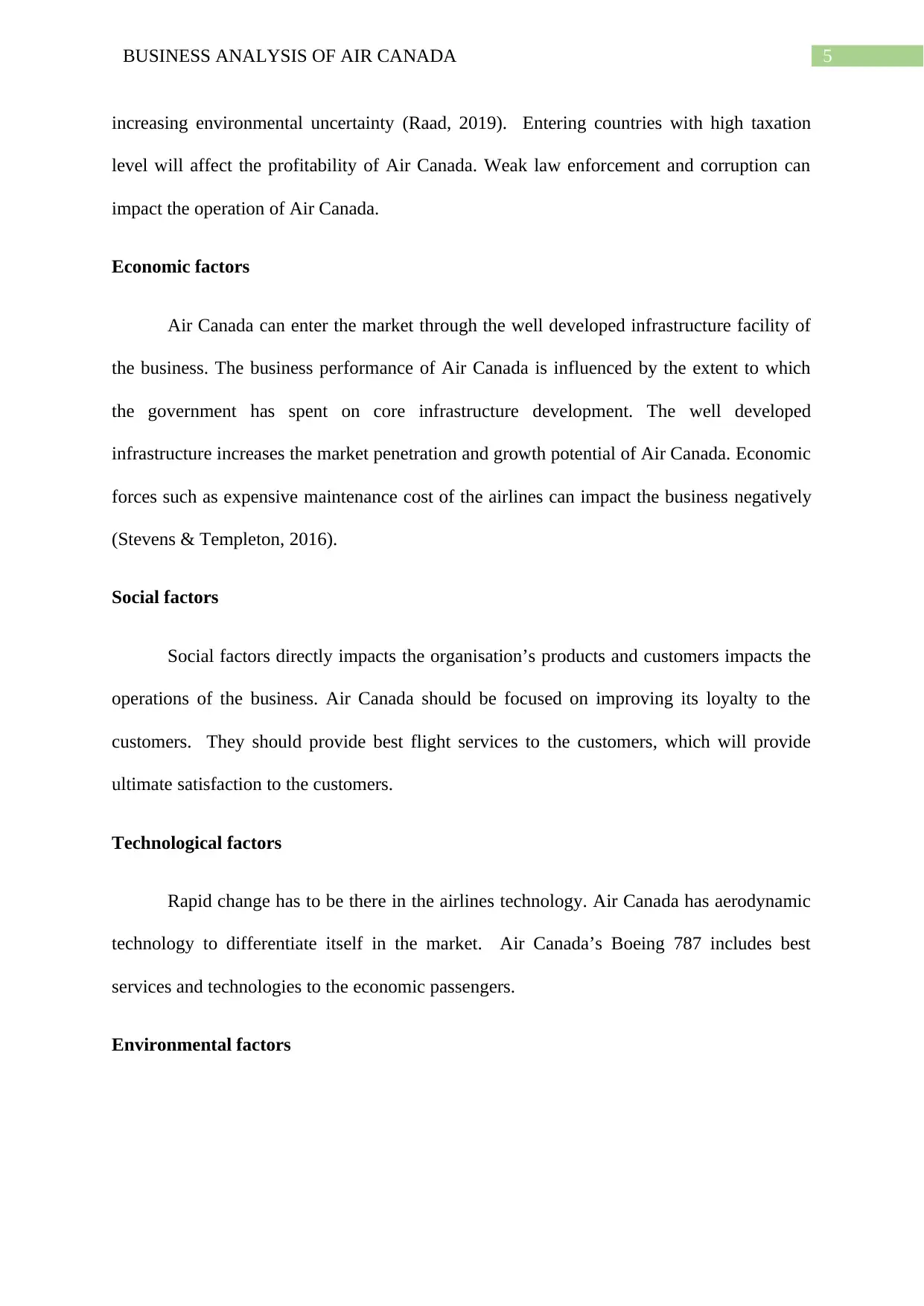
5BUSINESS ANALYSIS OF AIR CANADA
increasing environmental uncertainty (Raad, 2019). Entering countries with high taxation
level will affect the profitability of Air Canada. Weak law enforcement and corruption can
impact the operation of Air Canada.
Economic factors
Air Canada can enter the market through the well developed infrastructure facility of
the business. The business performance of Air Canada is influenced by the extent to which
the government has spent on core infrastructure development. The well developed
infrastructure increases the market penetration and growth potential of Air Canada. Economic
forces such as expensive maintenance cost of the airlines can impact the business negatively
(Stevens & Templeton, 2016).
Social factors
Social factors directly impacts the organisation’s products and customers impacts the
operations of the business. Air Canada should be focused on improving its loyalty to the
customers. They should provide best flight services to the customers, which will provide
ultimate satisfaction to the customers.
Technological factors
Rapid change has to be there in the airlines technology. Air Canada has aerodynamic
technology to differentiate itself in the market. Air Canada’s Boeing 787 includes best
services and technologies to the economic passengers.
Environmental factors
increasing environmental uncertainty (Raad, 2019). Entering countries with high taxation
level will affect the profitability of Air Canada. Weak law enforcement and corruption can
impact the operation of Air Canada.
Economic factors
Air Canada can enter the market through the well developed infrastructure facility of
the business. The business performance of Air Canada is influenced by the extent to which
the government has spent on core infrastructure development. The well developed
infrastructure increases the market penetration and growth potential of Air Canada. Economic
forces such as expensive maintenance cost of the airlines can impact the business negatively
(Stevens & Templeton, 2016).
Social factors
Social factors directly impacts the organisation’s products and customers impacts the
operations of the business. Air Canada should be focused on improving its loyalty to the
customers. They should provide best flight services to the customers, which will provide
ultimate satisfaction to the customers.
Technological factors
Rapid change has to be there in the airlines technology. Air Canada has aerodynamic
technology to differentiate itself in the market. Air Canada’s Boeing 787 includes best
services and technologies to the economic passengers.
Environmental factors
⊘ This is a preview!⊘
Do you want full access?
Subscribe today to unlock all pages.

Trusted by 1+ million students worldwide
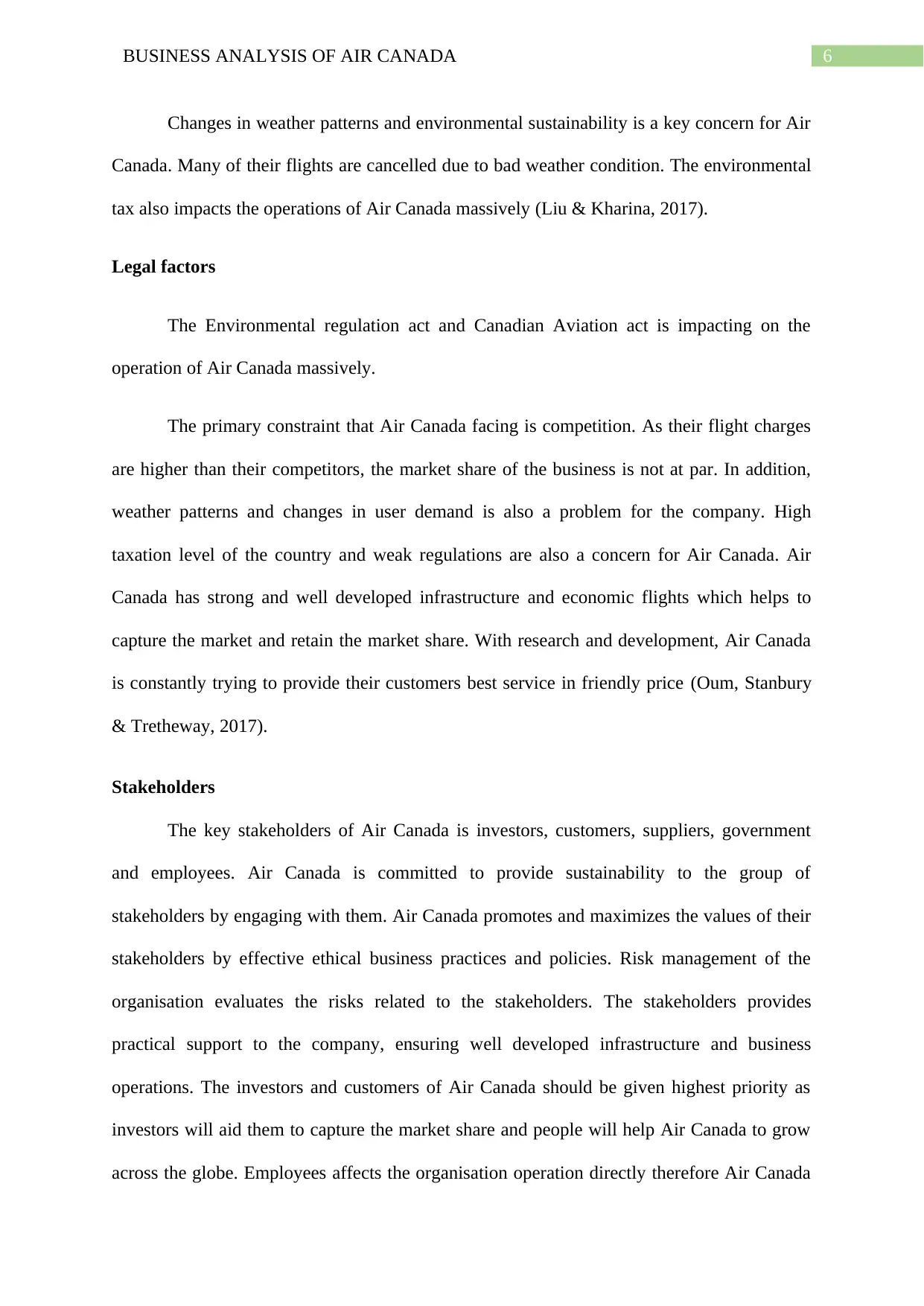
6BUSINESS ANALYSIS OF AIR CANADA
Changes in weather patterns and environmental sustainability is a key concern for Air
Canada. Many of their flights are cancelled due to bad weather condition. The environmental
tax also impacts the operations of Air Canada massively (Liu & Kharina, 2017).
Legal factors
The Environmental regulation act and Canadian Aviation act is impacting on the
operation of Air Canada massively.
The primary constraint that Air Canada facing is competition. As their flight charges
are higher than their competitors, the market share of the business is not at par. In addition,
weather patterns and changes in user demand is also a problem for the company. High
taxation level of the country and weak regulations are also a concern for Air Canada. Air
Canada has strong and well developed infrastructure and economic flights which helps to
capture the market and retain the market share. With research and development, Air Canada
is constantly trying to provide their customers best service in friendly price (Oum, Stanbury
& Tretheway, 2017).
Stakeholders
The key stakeholders of Air Canada is investors, customers, suppliers, government
and employees. Air Canada is committed to provide sustainability to the group of
stakeholders by engaging with them. Air Canada promotes and maximizes the values of their
stakeholders by effective ethical business practices and policies. Risk management of the
organisation evaluates the risks related to the stakeholders. The stakeholders provides
practical support to the company, ensuring well developed infrastructure and business
operations. The investors and customers of Air Canada should be given highest priority as
investors will aid them to capture the market share and people will help Air Canada to grow
across the globe. Employees affects the organisation operation directly therefore Air Canada
Changes in weather patterns and environmental sustainability is a key concern for Air
Canada. Many of their flights are cancelled due to bad weather condition. The environmental
tax also impacts the operations of Air Canada massively (Liu & Kharina, 2017).
Legal factors
The Environmental regulation act and Canadian Aviation act is impacting on the
operation of Air Canada massively.
The primary constraint that Air Canada facing is competition. As their flight charges
are higher than their competitors, the market share of the business is not at par. In addition,
weather patterns and changes in user demand is also a problem for the company. High
taxation level of the country and weak regulations are also a concern for Air Canada. Air
Canada has strong and well developed infrastructure and economic flights which helps to
capture the market and retain the market share. With research and development, Air Canada
is constantly trying to provide their customers best service in friendly price (Oum, Stanbury
& Tretheway, 2017).
Stakeholders
The key stakeholders of Air Canada is investors, customers, suppliers, government
and employees. Air Canada is committed to provide sustainability to the group of
stakeholders by engaging with them. Air Canada promotes and maximizes the values of their
stakeholders by effective ethical business practices and policies. Risk management of the
organisation evaluates the risks related to the stakeholders. The stakeholders provides
practical support to the company, ensuring well developed infrastructure and business
operations. The investors and customers of Air Canada should be given highest priority as
investors will aid them to capture the market share and people will help Air Canada to grow
across the globe. Employees affects the organisation operation directly therefore Air Canada
Paraphrase This Document
Need a fresh take? Get an instant paraphrase of this document with our AI Paraphraser
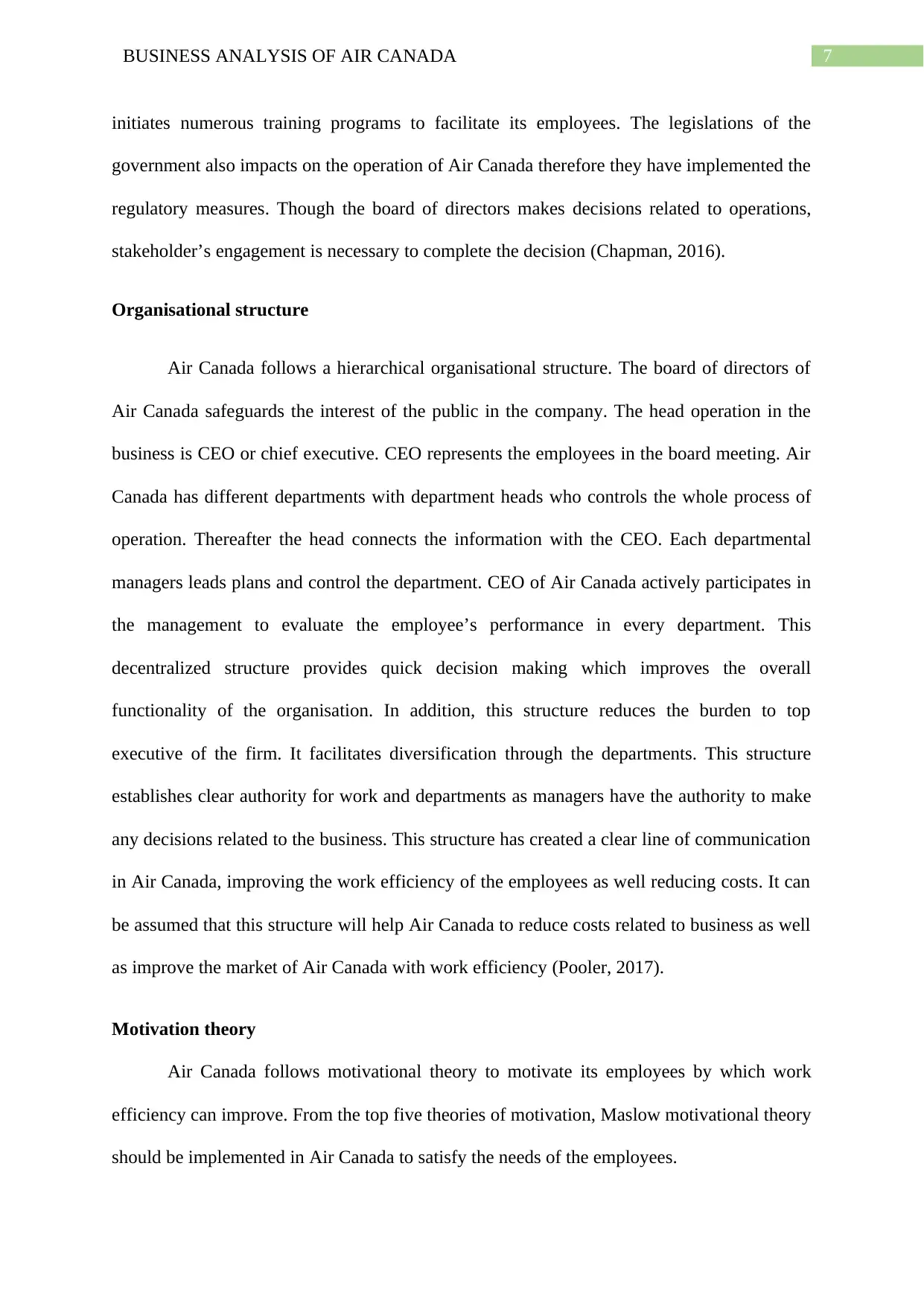
7BUSINESS ANALYSIS OF AIR CANADA
initiates numerous training programs to facilitate its employees. The legislations of the
government also impacts on the operation of Air Canada therefore they have implemented the
regulatory measures. Though the board of directors makes decisions related to operations,
stakeholder’s engagement is necessary to complete the decision (Chapman, 2016).
Organisational structure
Air Canada follows a hierarchical organisational structure. The board of directors of
Air Canada safeguards the interest of the public in the company. The head operation in the
business is CEO or chief executive. CEO represents the employees in the board meeting. Air
Canada has different departments with department heads who controls the whole process of
operation. Thereafter the head connects the information with the CEO. Each departmental
managers leads plans and control the department. CEO of Air Canada actively participates in
the management to evaluate the employee’s performance in every department. This
decentralized structure provides quick decision making which improves the overall
functionality of the organisation. In addition, this structure reduces the burden to top
executive of the firm. It facilitates diversification through the departments. This structure
establishes clear authority for work and departments as managers have the authority to make
any decisions related to the business. This structure has created a clear line of communication
in Air Canada, improving the work efficiency of the employees as well reducing costs. It can
be assumed that this structure will help Air Canada to reduce costs related to business as well
as improve the market of Air Canada with work efficiency (Pooler, 2017).
Motivation theory
Air Canada follows motivational theory to motivate its employees by which work
efficiency can improve. From the top five theories of motivation, Maslow motivational theory
should be implemented in Air Canada to satisfy the needs of the employees.
initiates numerous training programs to facilitate its employees. The legislations of the
government also impacts on the operation of Air Canada therefore they have implemented the
regulatory measures. Though the board of directors makes decisions related to operations,
stakeholder’s engagement is necessary to complete the decision (Chapman, 2016).
Organisational structure
Air Canada follows a hierarchical organisational structure. The board of directors of
Air Canada safeguards the interest of the public in the company. The head operation in the
business is CEO or chief executive. CEO represents the employees in the board meeting. Air
Canada has different departments with department heads who controls the whole process of
operation. Thereafter the head connects the information with the CEO. Each departmental
managers leads plans and control the department. CEO of Air Canada actively participates in
the management to evaluate the employee’s performance in every department. This
decentralized structure provides quick decision making which improves the overall
functionality of the organisation. In addition, this structure reduces the burden to top
executive of the firm. It facilitates diversification through the departments. This structure
establishes clear authority for work and departments as managers have the authority to make
any decisions related to the business. This structure has created a clear line of communication
in Air Canada, improving the work efficiency of the employees as well reducing costs. It can
be assumed that this structure will help Air Canada to reduce costs related to business as well
as improve the market of Air Canada with work efficiency (Pooler, 2017).
Motivation theory
Air Canada follows motivational theory to motivate its employees by which work
efficiency can improve. From the top five theories of motivation, Maslow motivational theory
should be implemented in Air Canada to satisfy the needs of the employees.
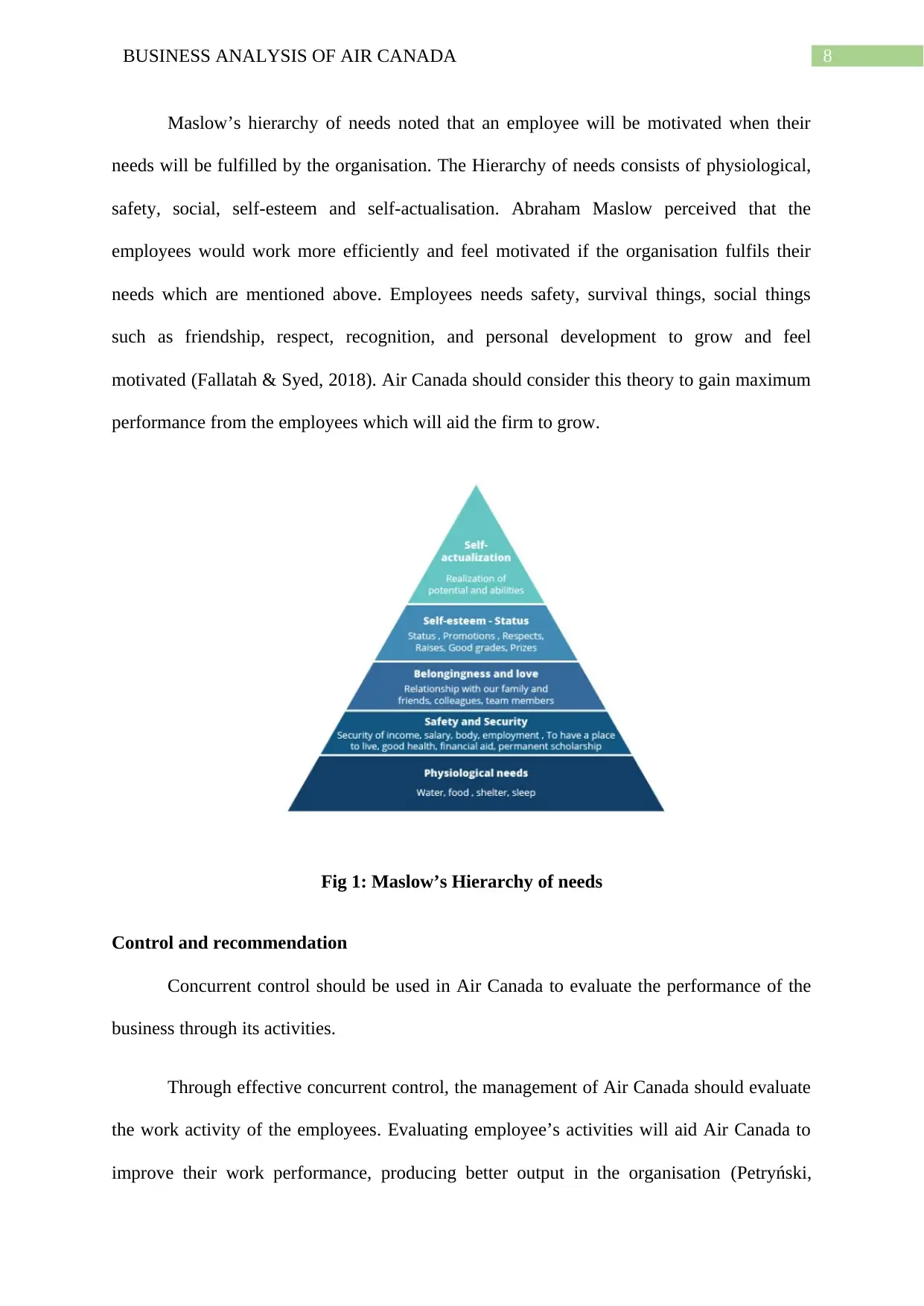
8BUSINESS ANALYSIS OF AIR CANADA
Maslow’s hierarchy of needs noted that an employee will be motivated when their
needs will be fulfilled by the organisation. The Hierarchy of needs consists of physiological,
safety, social, self-esteem and self-actualisation. Abraham Maslow perceived that the
employees would work more efficiently and feel motivated if the organisation fulfils their
needs which are mentioned above. Employees needs safety, survival things, social things
such as friendship, respect, recognition, and personal development to grow and feel
motivated (Fallatah & Syed, 2018). Air Canada should consider this theory to gain maximum
performance from the employees which will aid the firm to grow.
Fig 1: Maslow’s Hierarchy of needs
Control and recommendation
Concurrent control should be used in Air Canada to evaluate the performance of the
business through its activities.
Through effective concurrent control, the management of Air Canada should evaluate
the work activity of the employees. Evaluating employee’s activities will aid Air Canada to
improve their work performance, producing better output in the organisation (Petryński,
Maslow’s hierarchy of needs noted that an employee will be motivated when their
needs will be fulfilled by the organisation. The Hierarchy of needs consists of physiological,
safety, social, self-esteem and self-actualisation. Abraham Maslow perceived that the
employees would work more efficiently and feel motivated if the organisation fulfils their
needs which are mentioned above. Employees needs safety, survival things, social things
such as friendship, respect, recognition, and personal development to grow and feel
motivated (Fallatah & Syed, 2018). Air Canada should consider this theory to gain maximum
performance from the employees which will aid the firm to grow.
Fig 1: Maslow’s Hierarchy of needs
Control and recommendation
Concurrent control should be used in Air Canada to evaluate the performance of the
business through its activities.
Through effective concurrent control, the management of Air Canada should evaluate
the work activity of the employees. Evaluating employee’s activities will aid Air Canada to
improve their work performance, producing better output in the organisation (Petryński,
⊘ This is a preview!⊘
Do you want full access?
Subscribe today to unlock all pages.

Trusted by 1+ million students worldwide
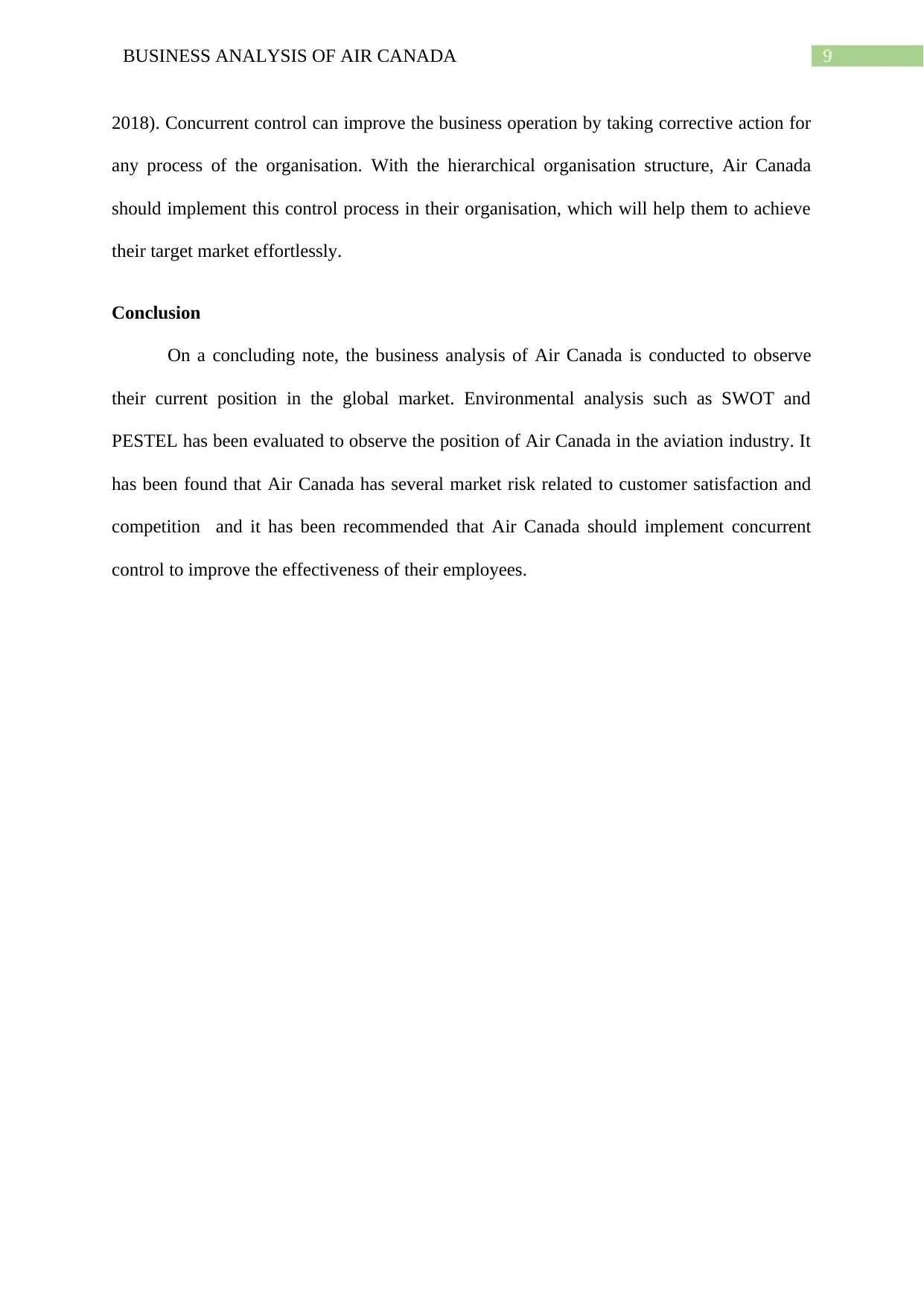
9BUSINESS ANALYSIS OF AIR CANADA
2018). Concurrent control can improve the business operation by taking corrective action for
any process of the organisation. With the hierarchical organisation structure, Air Canada
should implement this control process in their organisation, which will help them to achieve
their target market effortlessly.
Conclusion
On a concluding note, the business analysis of Air Canada is conducted to observe
their current position in the global market. Environmental analysis such as SWOT and
PESTEL has been evaluated to observe the position of Air Canada in the aviation industry. It
has been found that Air Canada has several market risk related to customer satisfaction and
competition and it has been recommended that Air Canada should implement concurrent
control to improve the effectiveness of their employees.
2018). Concurrent control can improve the business operation by taking corrective action for
any process of the organisation. With the hierarchical organisation structure, Air Canada
should implement this control process in their organisation, which will help them to achieve
their target market effortlessly.
Conclusion
On a concluding note, the business analysis of Air Canada is conducted to observe
their current position in the global market. Environmental analysis such as SWOT and
PESTEL has been evaluated to observe the position of Air Canada in the aviation industry. It
has been found that Air Canada has several market risk related to customer satisfaction and
competition and it has been recommended that Air Canada should implement concurrent
control to improve the effectiveness of their employees.
Paraphrase This Document
Need a fresh take? Get an instant paraphrase of this document with our AI Paraphraser
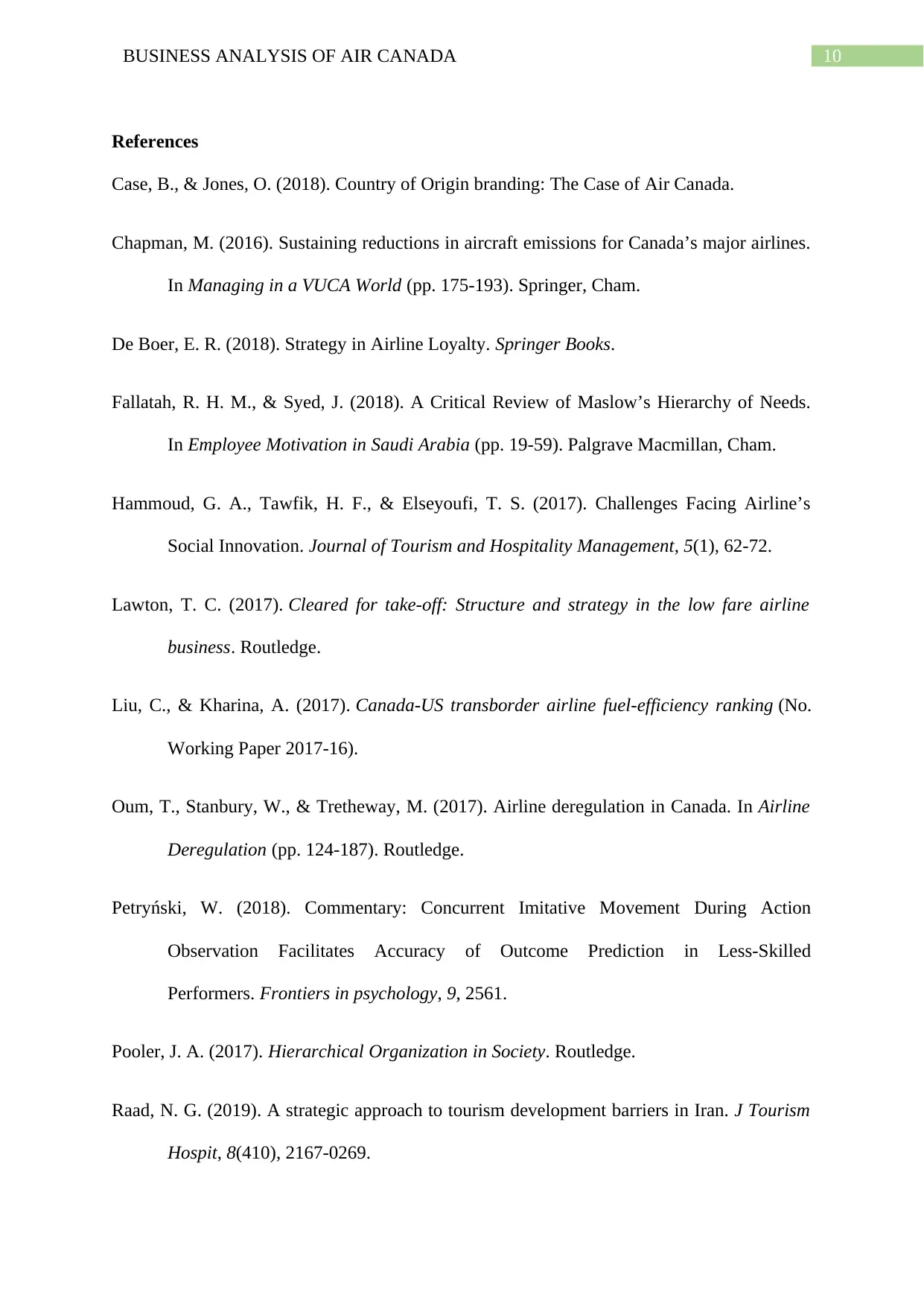
10BUSINESS ANALYSIS OF AIR CANADA
References
Case, B., & Jones, O. (2018). Country of Origin branding: The Case of Air Canada.
Chapman, M. (2016). Sustaining reductions in aircraft emissions for Canada’s major airlines.
In Managing in a VUCA World (pp. 175-193). Springer, Cham.
De Boer, E. R. (2018). Strategy in Airline Loyalty. Springer Books.
Fallatah, R. H. M., & Syed, J. (2018). A Critical Review of Maslow’s Hierarchy of Needs.
In Employee Motivation in Saudi Arabia (pp. 19-59). Palgrave Macmillan, Cham.
Hammoud, G. A., Tawfik, H. F., & Elseyoufi, T. S. (2017). Challenges Facing Airline’s
Social Innovation. Journal of Tourism and Hospitality Management, 5(1), 62-72.
Lawton, T. C. (2017). Cleared for take-off: Structure and strategy in the low fare airline
business. Routledge.
Liu, C., & Kharina, A. (2017). Canada-US transborder airline fuel-efficiency ranking (No.
Working Paper 2017-16).
Oum, T., Stanbury, W., & Tretheway, M. (2017). Airline deregulation in Canada. In Airline
Deregulation (pp. 124-187). Routledge.
Petryński, W. (2018). Commentary: Concurrent Imitative Movement During Action
Observation Facilitates Accuracy of Outcome Prediction in Less-Skilled
Performers. Frontiers in psychology, 9, 2561.
Pooler, J. A. (2017). Hierarchical Organization in Society. Routledge.
Raad, N. G. (2019). A strategic approach to tourism development barriers in Iran. J Tourism
Hospit, 8(410), 2167-0269.
References
Case, B., & Jones, O. (2018). Country of Origin branding: The Case of Air Canada.
Chapman, M. (2016). Sustaining reductions in aircraft emissions for Canada’s major airlines.
In Managing in a VUCA World (pp. 175-193). Springer, Cham.
De Boer, E. R. (2018). Strategy in Airline Loyalty. Springer Books.
Fallatah, R. H. M., & Syed, J. (2018). A Critical Review of Maslow’s Hierarchy of Needs.
In Employee Motivation in Saudi Arabia (pp. 19-59). Palgrave Macmillan, Cham.
Hammoud, G. A., Tawfik, H. F., & Elseyoufi, T. S. (2017). Challenges Facing Airline’s
Social Innovation. Journal of Tourism and Hospitality Management, 5(1), 62-72.
Lawton, T. C. (2017). Cleared for take-off: Structure and strategy in the low fare airline
business. Routledge.
Liu, C., & Kharina, A. (2017). Canada-US transborder airline fuel-efficiency ranking (No.
Working Paper 2017-16).
Oum, T., Stanbury, W., & Tretheway, M. (2017). Airline deregulation in Canada. In Airline
Deregulation (pp. 124-187). Routledge.
Petryński, W. (2018). Commentary: Concurrent Imitative Movement During Action
Observation Facilitates Accuracy of Outcome Prediction in Less-Skilled
Performers. Frontiers in psychology, 9, 2561.
Pooler, J. A. (2017). Hierarchical Organization in Society. Routledge.
Raad, N. G. (2019). A strategic approach to tourism development barriers in Iran. J Tourism
Hospit, 8(410), 2167-0269.
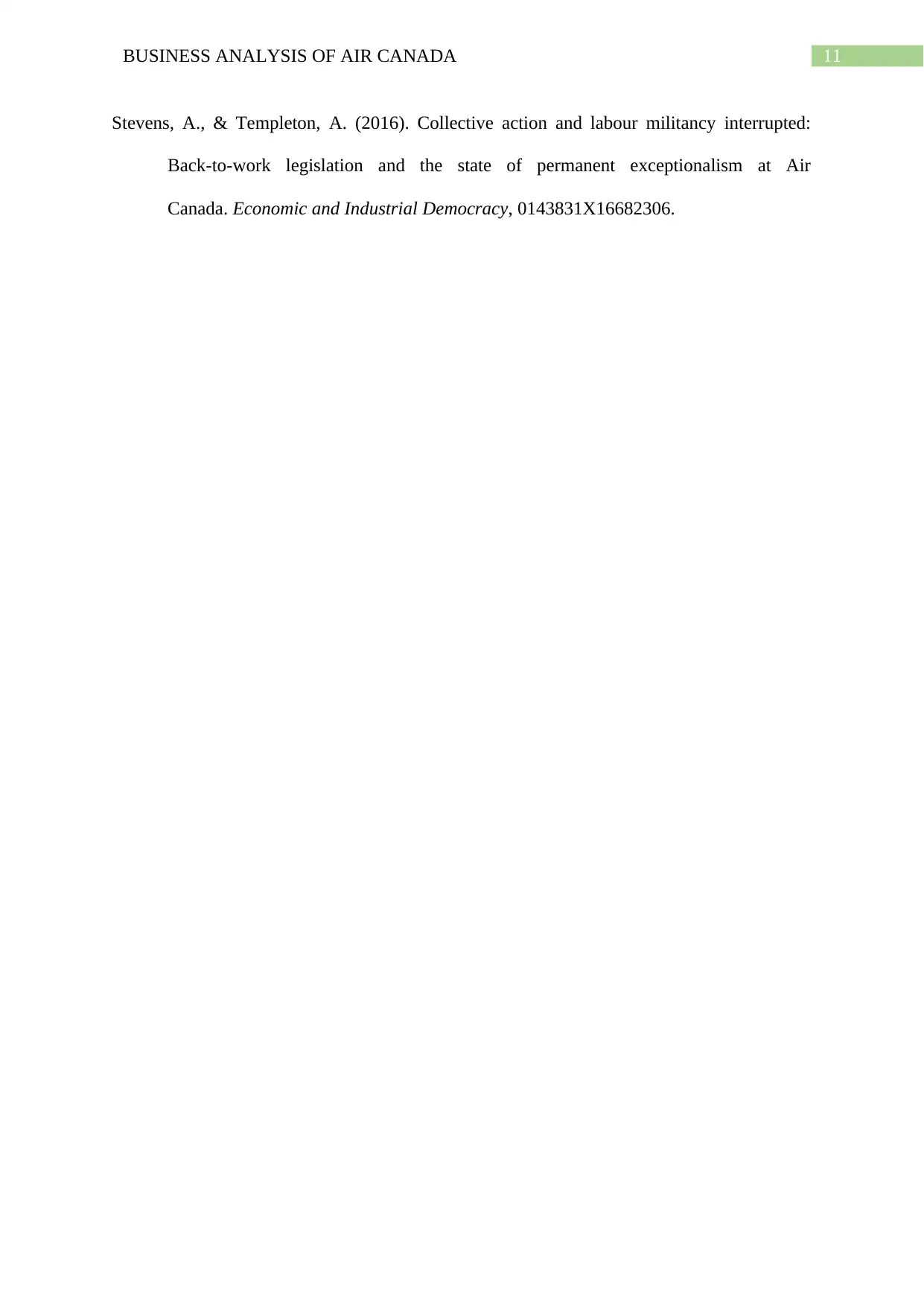
11BUSINESS ANALYSIS OF AIR CANADA
Stevens, A., & Templeton, A. (2016). Collective action and labour militancy interrupted:
Back-to-work legislation and the state of permanent exceptionalism at Air
Canada. Economic and Industrial Democracy, 0143831X16682306.
Stevens, A., & Templeton, A. (2016). Collective action and labour militancy interrupted:
Back-to-work legislation and the state of permanent exceptionalism at Air
Canada. Economic and Industrial Democracy, 0143831X16682306.
⊘ This is a preview!⊘
Do you want full access?
Subscribe today to unlock all pages.

Trusted by 1+ million students worldwide
1 out of 12
Related Documents
Your All-in-One AI-Powered Toolkit for Academic Success.
+13062052269
info@desklib.com
Available 24*7 on WhatsApp / Email
![[object Object]](/_next/static/media/star-bottom.7253800d.svg)
Unlock your academic potential
Copyright © 2020–2025 A2Z Services. All Rights Reserved. Developed and managed by ZUCOL.





